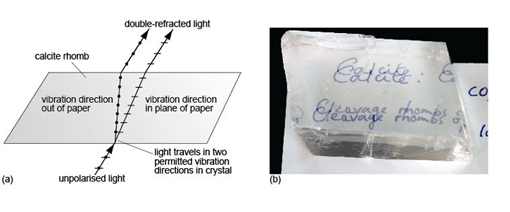2.2.2 Double refraction
Anisotropic crystals have a remarkable property: when plane-polarised light enters such a crystal, it splits into two rays. The explanation for this involves complex crystal physics, which is well beyond the scope of this course. Nevertheless, the consequences are profound. The two rays are each plane-polarised, but their planes of polarisation (i.e. their vibration directions) are at 90° to each other. This means that each ray encounters a different atomic arrangement and therefore travels at a different speed through the crystal - so they have different refractive indices. The difference in refractive index of the two rays is called birefringence. If the refractive indices are very different (i.e. the crystal has a very high birefringence), then the two rays will be refracted to very different extents, and it may be possible to view two distinct images through the crystal, one for each ray. This effect, called double refraction, can be seen in the transparent variety of calcite, Iceland spar (Figure 29).

-
Would you expect to see double refraction in a cubic crystal?
-
No. Cubic crystals are isotropic. Double refraction occurs only in anisotropic crystals.
